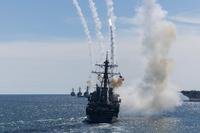A Navy warship in the Red Sea on Wednesday again shot down a threatening drone when it got too close and forced the crew to take defensive actions, according to the Pentagon.
The drone came from Yemen and was heading in the direction of the USS Thomas Hudner destroyer, which was in international waters, when the shoot-down occurred, the Pentagon said in a released statement.
It was the latest in a series of confrontations in the region as the U.S. military deployed forces to deter a regional conflict amid the Israel-Hamas war. Another destroyer fired on drones and missiles from Yemen last month, and there have been near daily drone and rocket attacks by Iran-backed groups on U.S. troops in Iraq and Syria that have caused traumatic brain injuries.
Read Next: Soldier and Family Found Dead in Home at Fort Stewart, Army Investigation Underway
"Our assessment right now is that the intended target was not the Hudner, but that the drone got so close to the crew that the commander did feel it necessary to engage and shoot down the drone," Pentagon spokeswoman Sabrina Singh told reporters Thursday.
Singh said she could not confirm whether the drone belonged to the Houthis, an Iran-backed rebel group that has waged civil war in Yemen for years and more recently waged strikes on Israel as it wages war on Hamas.
"We're still doing an assessment of the ownership," she said.
Singh said she didn't know how close the drone actually got to the ship, and she wouldn't say what weapons the crew used to take it out. A Navy official told Military.com that the Hudner is now in the Gulf of Aden.
The incident comes just over a month after another guided-missile destroyer, the USS Carney, shot down four missiles and 15 drones over the Red Sea that were launched by the Houthis in Yemen, as well as an ever-growing rate of drone and missile strikes on U.S. bases across the Middle East that the Pentagon has also attributed to groups aligned with Iran.
Defense Secretary Lloyd Austin told reporters while traveling in Indonesia Thursday that he expects to see more of these incidents -- both attacks in Iraq and Syria as well as Houthi weapons launches.
The two at-sea, shoot-down incidents shared a strong resemblance. Neither ship was explicitly targeted but rather found itself along the flight path of drones that may have been headed elsewhere, according to the Pentagon's description.
The missiles and drones shot down by the Carney were launched north along the Red Sea and not directly at the ship but "potentially toward targets in Israel," the Pentagon said in October.
Brig. Gen. Pat Ryder, the Pentagon's top spokesman, also later clarified that the assessment was based largely on the direction of the missiles' flight rather than a deeper understanding of their range and capabilities.
Ryder also wouldn't say whether the threat they posed was to the ship or Israel at the time.
Meanwhile, land attacks against U.S. forces in the region continue. The Pentagon said it was a total of 58 since Oct. 17, despite three retaliatory U.S. airstrikes against Iranian-backed militia targets in Syria meant to deter the activity.
"Is deterrence working? We feel that it is. We have not seen this war spread into a wider regional conflict," Singh told reporters Tuesday.
Austin said that the current attacks hadn't reached the threshold of a wider regional conflict.
Pressed by reporters, Austin added that, "If you saw us in a fight with Iran or if you saw us in a fight with the Houthis, an all-out fight, I think that's a regional conflict."
-- Konstantin Toropin can be reached at konstantin.toropin@military.com. Follow him on X at @ktoropin.













